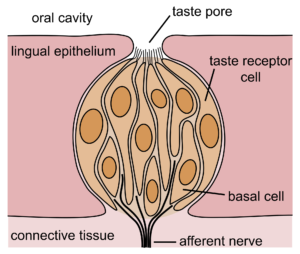Taste vs Smell – Sensory Symbiosis.
At the time of year when our taste buds are pushed to the limit with the over indulgence of almost every type of food and drink on offer, we look at taste vs smell to see how closely they work together, which allows us to enjoy such fantastic aromas and flavours.
Smell You Later
As you may or may not know, taste and smell are separate senses with their own receptor organs, yet they are intimately entwined. Tastants (which are chemicals in foods) are detected by taste buds, which consist of special sensory cells. When stimulated, these cells send signals to specific areas of the brain, which make us conscious of the perception of taste. Similarly, specialised Cells in the nose pick up odorants, airborne odour molecules.
Odorants stimulate receptor proteins found on hair-like olfactory cilia at the tips of the sensory cells, a process that initiates a neural response. This means messages about taste and smell converge, allowing us to detect the flavours of food.

There’s Something In The Air
We are all familiar of that feeling, when sound’s awareness to changes in air pressure and sight’s awareness to changes in light, taste’s and smells are aware of chemical changes in the air and in food. Even though taste and smell are separate senses with their own receptor organs, they are nonetheless intimately entwined.
This close relationship is most apparent in how we perceive the flavours of food. As anyone with a head cold have witnessed, food does taste different when the sense of smell is impaired. Actually, what is really being affected is the flavour of the food or the combination of taste and smell. That’s because only the taste, not the food odours, are being detected. The taste itself is focused on distinguishing chemicals that have a sweet, salty, sour, bitter, or umami taste (umami is Japanese for savoury).
However, interactions between the senses of taste and smell enhance our perceptions of the foods we eat.
Do You Have Good Taste?
Tastants, which are chemicals in foods (as mentioned above) are detected by taste-buds, special structures embedded within small protuberances on the tongue called papillae. Other taste buds are found in the back of the mouth and on the palate. Every person has between 5,000 and 10,000 taste buds…WOW! Each taste bud consists of 50 to 100 specialised sensory cells, which are stimulated by tastants such as sugars, salts, or acids. When the sensory cells are stimulated, they cause signals to be transferred to the ends of nerve fibres, which send impulses along cranial nerves to taste regions in the brain stem.
From here, the impulses are relayed to the thalamus and on to a specific area of the cerebral cortex. This makes us conscious of the perception of taste.
Molecules And Mucus Membranes
Airborne odour molecules which are called odorants, are detected by specialised sensory neurons located in a small patch of the mucus membrane lining the roof of the nose. Axons of these sensory cells pass through perforations in the overlying bone and enter two elongated olfactory bulbs lying against the underside of the frontal lobe of the brain.
Odorants stimulate receptor proteins found on hair-like cilia at the tips of the sensory cells, a process that initiates a neural response. An odorant acts on more than one receptor but does so to varying degrees.

Similarly, a single receptor interacts with more than one different odorant, though also to varying degrees. Therefore, each odorant has its own pattern of activity, which is set up in the sensory neurons. This pattern of activity is then sent to the olfactory bulb, where other neurons are activated to form a spatial map of the odour. Neural activity created by this stimulation passes to the primary olfactory cortex at the back of the underside, or orbital, part of the frontal lobe. Olfactory information then passes to adjacent parts of the orbital cortex, where the combination of odour and taste information helps create the perception of flavour.
Taste vs Smell – COVID-19 Criteria
It is also unclear as to why people have lost their taste and sense of smell when contracting COVID-19? There are theories, but nothing official as yet. People who lose their sense of taste and smell usually get it back within 7 days, but some have reported it can take up to 28 days to get their taste or smell back after having the virus. There is still so much unknown regarding the COVID-19 virus, but there are hundreds of ongoing studies that will shed light on the virus, which will inevitably help us understand it more in the long-term.
In addition to a loss of smell or taste, there are several other symptoms to watch out for with COVID-19. Some of the most common symptoms include:
- fever
- cough
- fatigue
- shortness of breath
- aches and pains
- chills
- sore throat
- headaches
- stuffy or runny nose
- diarrhoea, nausea, and vomiting
If you think you may have COVID-19, stay home and try to isolate yourself from others in your household.
Contact your doctor to discuss your symptoms. Your doctor can also advise you on getting tested and how to care for yourself if you test positive for COVID-19.
If you found this post useful, then please comment below and let me know your thoughts as I would love to hear them.
Please don’t forget to check out other posts and YouTube Channel (don’t forget to subscribe) for the latest health and fitness news, CBD news, along with product reviews, meditations, recipes, workouts and if you require any CBD for you post workout therapy needs, please take a look at our store to get hold of yours now.


HI Lee
Many thanks for this. I am lucky to have a really good sense of smell (my husband says if the sniffer dog was off ill at the airport, I would do a brilliant job!) and I think it probably contributes to how much I enjoy my food too!
My taste buds have indeed been pushed to the limit with seriously too much garlic in the bruschetta! (Good thing I am working on my own today!)
The fact that losing your sense of smell and / or taste is useful symptom to know about where Covid is concerned.
Thanks for another interesting post.
Best,
Jean
Hi Jean,
thanks for the comments, that’s funny regarding the sniffer dogs and your sense of smell! It is handy to know. If I ever see you sniffing suitcases ill know you’ve been drafted in! haha.
I think your right regarding your love of food with how powerful your sense of smell is, good observation there. As you know both senses are intertwined and work closely together. The sensations we feel when we smell or taste can have a profound effect on us in that moment but also years after too.
A perfume or a favourite family recipe can unlock so many emotions and can take you back many years, which is also an interesting thought.
Thanks again.
I learned a lot about taste and smell from your post. I sort of take them for granted and forget what it would be like if they did not work properly.
I appreciate the read on how you related taste and smell to Covid.
The body is certainly very complex. Each thing has to work in harmony.
I wonder if there are any other diseases like Covid that have impacted the bodies taste and small.
Hi George,
I hope you are well?
I agree that lots of people do take their senses for granted, but its always interesting to know how we function. Glad you learnt from this post as I want the site to be of use to people who are interested about how we work on a cellular level… I find it fascinating and hope others do too.
Happy new year and speak soon.
Thank you, very interesting article. Taste and smell are things I did not consider the science of why and how behind them and wow I never dreamed we had up to 10 000 taste buds!
Hi Maddie,
Glad you found the post interesting. It is amazing to think that we have so many taste buds, I’ve always found taste vs smell to be quite interesting as they work so intricately together.
Hopefully, this post has awakened some other peoples taste buds to the possibilities of how they work together.
Thanks.
Very interesting indeed. I learned a lot about sensory perception, thank u. This is exactly what I was looking for.
Regards,
Aps
Hi Aps,
glad it was helpful to you. I find taste vs smell to be a really interesting topic. The human body in general is a fantastic working machine (if you were to call it that). It really is mind blowing to know how we work.
Please check back in soon for more in depth information regarding human anatomy, as we will be posting more in the near future.
Thanks.
That’s great information. I don’t think I have a great sense of taste or smell. You gave a great explanation as to how they work together. Do you suppose that’s why we plug our nose if we’re about to eat something nasty? LOL!
I must say this is a really interesting post I have read today. It is amazing to know how our senses play a massive role in our health and wellbeing and we take them for granted. Also how they work together.
As a covid survivor, I highly appreciate my senses of taste and smell which I did not have for a few months post covid diagnosis.
Hi mate,
this is so true that we all take our health for granted, until something happens which may compromise that.
You say that you just got over COVID? I hope you are over the worst now and are on the road to recovery.
The connection between taste and smell is very important, as they work in tandem to allow us to enjoy all the flavours and aromas that we do.
I think its also important to raise awareness of how we work, so that we can get to understand ourselves better and not take ourselves for granted and some do.
Thanks for stopping by as ever mate and get well soon!
I’m really impressed together with your writing talents as smartly as with the format to your blog. Is this a paid theme or did you customize it yourself?
Either way stay up the excellent quality writing, it is uncommon to peer a nice weblog like this one these days.
Thank you so much for the kind words! I’m really glad you’re enjoying the content and the look of the blog.
The theme is customised to give it a personal touch, but it’s always a work in progress to make sure it matches the quality of the writing.
Appreciate your support—means a lot! 😊